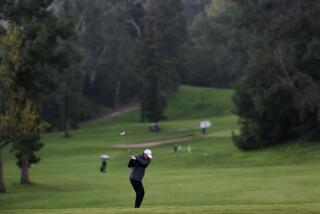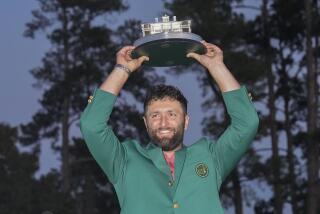Golf Suits Investor to a Tee : Toshio Kinoshita’s Love for Game Led to Business Empire
- Share via
CARLSBAD — Through four days of dark, rain-threatening skies, bone-chilling winds and occasional sunshine, 12 hours in all, he sat unobtrusively on the first tee, greeting professional golfers who were competing in the recent MONY Tournament of Champions at La Costa Resort Hotel and Spa.
Fans repeatedly applauded the long-driving pros but paid little attention to the trim, broad-shouldered Japanese tournament official with the gray-streaked hair, wide smile and humble demeanor--unaware, perhaps, that he heads a corporation that owned virtually everything in sight.
But in the world of high finance, Toshio Kinoshita--president of Sports Shinko Ltd. and the first Japanese general chairman of an American professional golf tournament--needs no introduction.
Nonetheless, his company’s last major purchase, a costly acquisition, can use all the media exposure it can get, and it received a considerable amount.
Situated on more than 420 acres, the sprawling, 23-year-old complex includes two 18-hole golf courses, 23 tennis courts, seven restaurants, a movie theater, a 60,000-square-foot spa, a 50,000-square-foot conference center and 480 rooms with daily rates that range from $180 to $1,400.
Sports Shinko, based in Osaka and Tokyo, employs 4,500 people, has assets of $2.7 billion, a working capital of $150 million and ambitious plans for growth.
Kinoshita founded the company 30 years ago--three years after going broke in his first major venture, an export-import business dealing in sundry goods. It lasted five years.
Asked what prompted him to start Sports Shinko, Kinoshita attempted to explain, finally deferring to the company’s managing director, Masao Wakamori, to clarify.
“Golf was a very high-class sport in Japan when he founded the company,” he said. “Everybody couldn’t play. He wanted to popularize golf. . . . He wanted to promote sports. He wanted to promote many different kinds of sports, out of which he chose golf as the best. Shinko means promotion.”
Still an avid (and sometimes frustrated) golfer who plays 70 to 80 rounds a year, Kinoshita has parlayed his love for a game he has been trying to master for three decades into huge profits. But thus far, not at La Costa.
“I cannot expect profits in the very near future,” Kinoshita said through Wakamori. “Profits may be four or five years away.”
Kinoshita, who speaks English but not fluently, was also assisted in the interview by the parent company’s general manager, Tsugio Fukuda, who said his boss intends to keep improving the resort “to make it the best in the world.”
Kinoshita didn’t rule out the possibility of expanding the complex if adjacent property could be acquired. Now, however, he is focusing on the East Coast.
“He wants to either buy or construct five to 10 more resorts,” Wakamori translated, “from Washington down the coast to Florida. He likes the beach side.”
Smiling broadly, Kinoshita said he is also seeking two more golf courses and hotels in Hawaii and plans to either buy or construct resorts on the Costa del Sol in Southern Spain and along the French Riviera.
“In Spain, we are in negotiation,” Wakamori added. “We hope to buy the land within a couple of months’ time.”
And Kinoshita hopes to play a big role in the shaping of it. He has designed 14 courses, all in Japan.
“My father was a painter,” he said, “oil painting, I think, and I--what do you say?--sculpture.”
The joke seemed to play well, judging from the laughter.
Sports Shinko has a variety of businesses in Japan--six hotels, two skiing resorts, a tennis resort, construction, insurance, financing and trading companies, a travel bureau, commercial buildings--but golf courses dominate the corporation’s holdings by a long shot.
The company owns 28 in Japan, three in Hawaii (Mililani Golf Club on Oahu, Kiahuna Golf Club on Maui and Pukalani Country Club on Kauai), three courses at the Grenlefe Resort near Orlando, Fla., and the two here.
Two months ago, Kinoshita opened a new course in Japan that offers memberships for $230,000, with annual dues of $300, plus a $50 fee for every round of golf. Drinks and food, of course, are extra.
Kinoshita purchased La Costa in November, 1987, from principal owners Allard Roen, Irwin Molasky and Merv Adelson for $250 million shortly after the hotel had undergone a two-year, $100-million-plus renovation. He then turned the management over to San Diego-based Global Hospitality Corp., whose chairman is Howard P. (Bud) James, former head of Sheraton Corp.
James’ son, Paul, the managing director, said Kinoshita doesn’t spend a lot of time at the resort, “but he wants to know what’s going on. He doesn’t want any surprises.
“The perception in the past was that this was a private, exclusive country club. It’s going to take time to change that thinking. La Costa is not inexpensive, but there are New York City and London hotels that charge more but don’t have the facilities or services that we do. We have over 1,400 employees, and that’s a big payroll.”
James said the hotel’s occupancy during the past year averaged 65%.
A driver who has worked under both ownerships has noticed few changes since the sale, “although now they give some parties that employees never got before.”
Last November, former Secretary of State Alexander Haig was a guest speaker at a party celebrating the resort’s first anniversary under the new owners.
“He gave a good speech,” an executive’s secretary recalled.
After 12 days at the resort, Junko Kinoshita--the 39-year-old wife of Toshio--was anxious to return to her Tokyo home and her 3-year-old daughter, Rika.
Employed by Prudential-Bache Securities (Japan) Inc. in Tokyo before her marriage five years ago, Junko Kinoshita is well-versed in the corporate world.
She speaks English well and, like her husband, is active in sports--but not golf especially. Her game is tennis, although she didn’t play here during her recent stay.
Kinoshita and his first wife, who died of cancer seven years ago, had three sons--Satoshi, 29, Takeshi, 27, and Toshiya, 23.
Takeshi Kinoshita, a slightly built, rather reserved young man, worked at one of Sports Shinko’s golf courses in Japan for a few months after graduating last June from Lynchburg College in Virginia, where he earned his master’s in business administration.
Shadowing his father during the tournament and attending various social functions, he undoubtedly took more than a few mental notes. In March, he will return to La Costa to start a training course under the guidance of Paul James.
“He’ll be working in food and beverages, housekeeping, property maintenance, retail operations, financial planning, budgeting, marketing, advertising,” James said. “It’s a two-year program, but even then it’s really a broad brush.”
The “No. 3 son,” Toshiya Kinoshita, apparently has no ambitions to follow in his father’s footsteps--except maybe on the golf course--and dad doesn’t seem to mind.
“He wants to be a professional golfer,” the sports-minded tycoon said proudly. “He has been playing for 12 years. He has a 3 handicap.”
Clearly, a young professional golfer in the Kinoshita family would be considered quite an honor.
Kinoshita has played host to the annual USA-Japan matches at the Sports Shinko Country Club in Osaka for nine years.
One day the host may be Satoshi Kinoshita, the eldest son. He graduated from the Tokyo Institute of Technology and is studying at George Washington University in Washington.
“He will be one of the successors,” the 61-year-old executive said, without elaborating.
At the time, a few days before his birthday, Kinoshita politely insisted that he was 60 and would not be one year older until Jan. 10.
He looks sturdy enough and carries himself well but acknowledged that his golf game has deteriorated badly over the years (from an 8 handicap to a 20) because of a history of physical ailments, including a “twisted spine.”
Playing in the pro-am with Steve Pate, the 1988 Tournament of Champions winner, Kinoshita was not having a spectacular round. In fact, he failed to break 100.
On the final hole, he lofted a short drive, barely clearing the water in front of him, then, several shots later, wound up in a bunker in front of the green. He blasted out, skulling the ball 30 feet past the pin. Undaunted, he calmly two-putted for a triple-bogey 7.
He graciously shook hands with his playing partners--Pate and amateurs Allard Roen, one of the former La Costa owners, and Jim Farley, the incoming president of MONY Financial Services, which sponsors the annual event, then headed for a shower before hosting a lavish party that night.
Later, Pate was asked to evaluate Kinoshita’s game.
“I don’t think he had a par,” he replied, obviously unimpressed. “But I’ll say this: There was probably more money among that threesome than in half the states in the country.”
More to Read
Inside the business of entertainment
The Wide Shot brings you news, analysis and insights on everything from streaming wars to production — and what it all means for the future.
You may occasionally receive promotional content from the Los Angeles Times.










